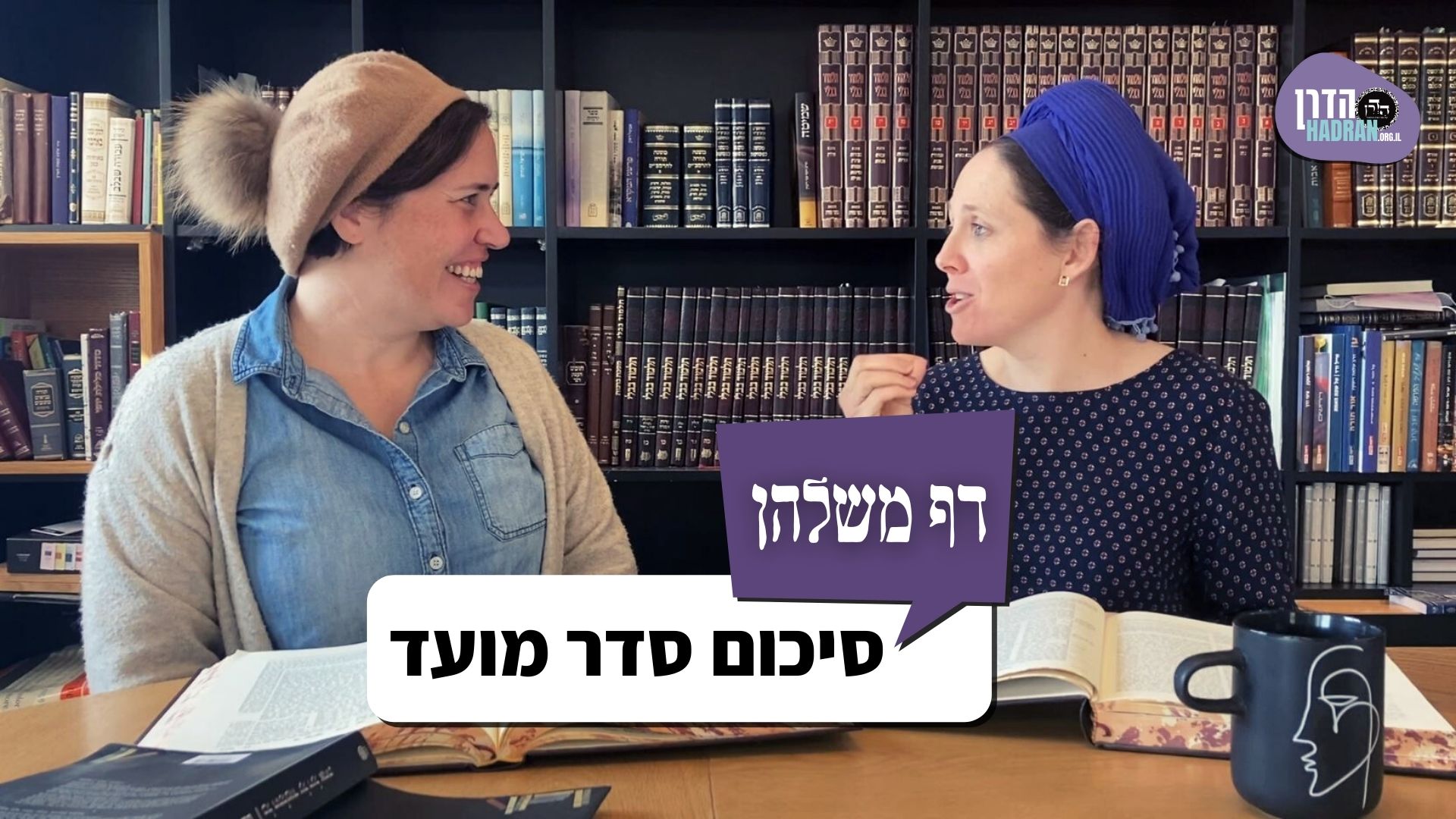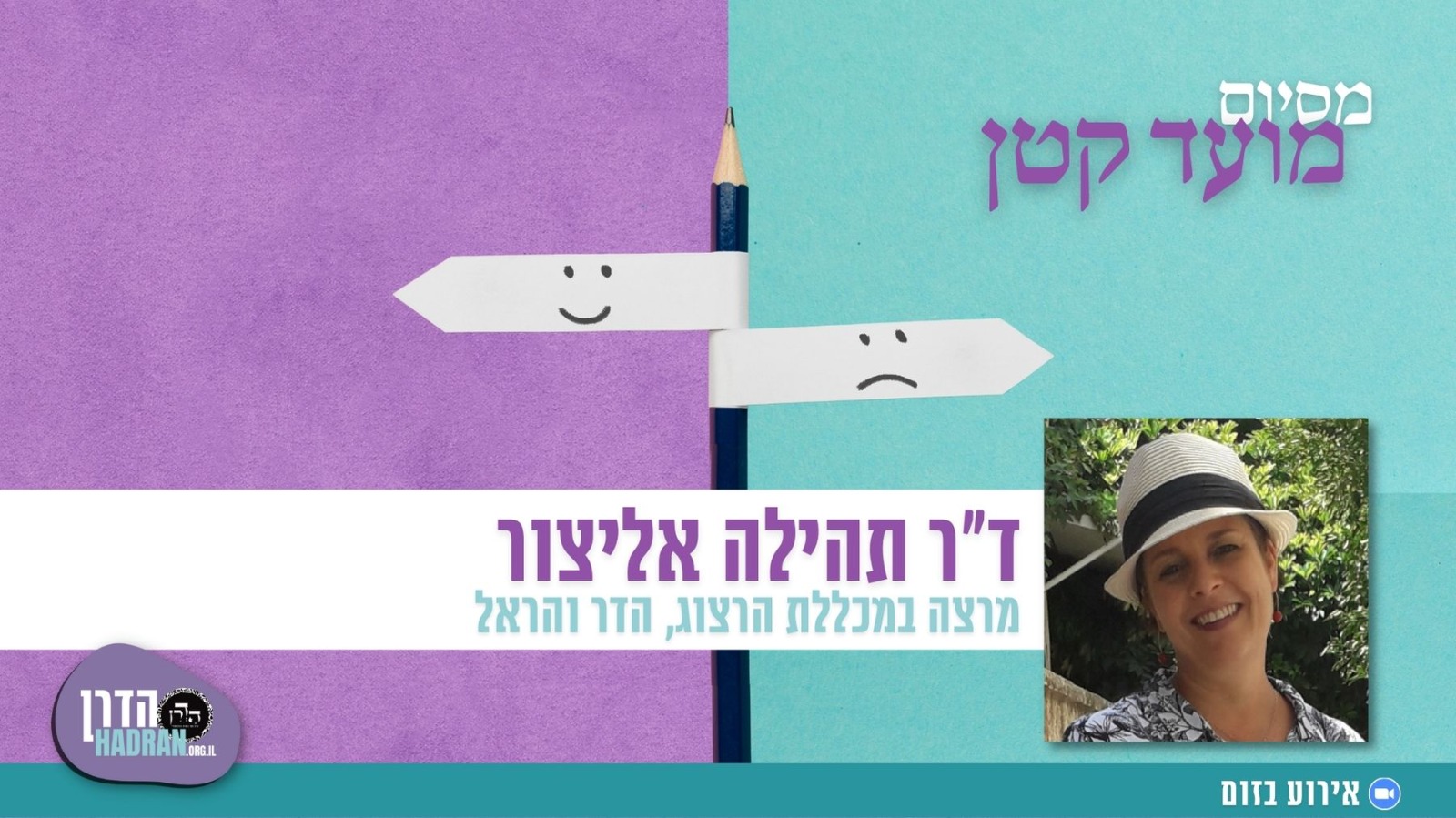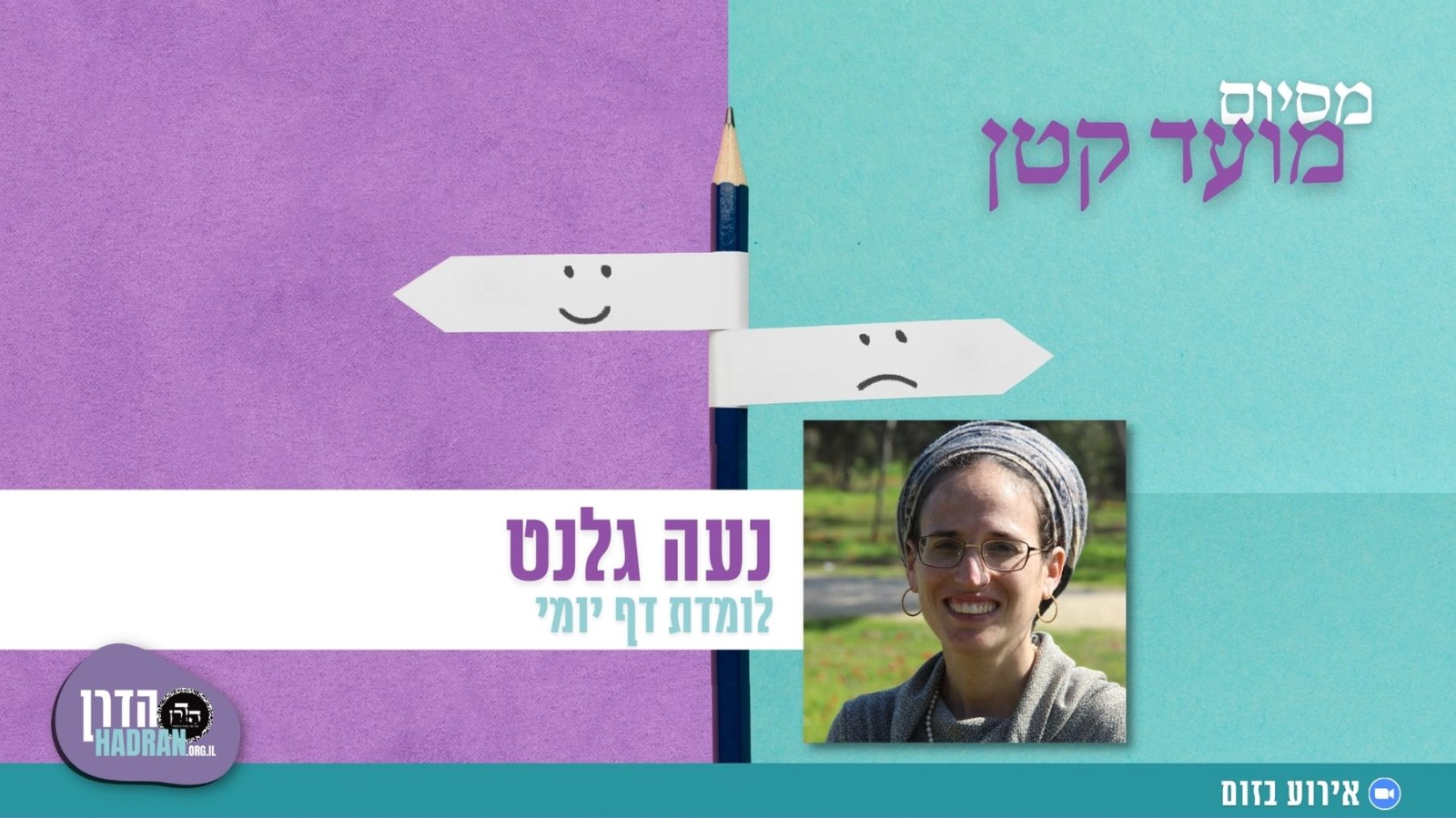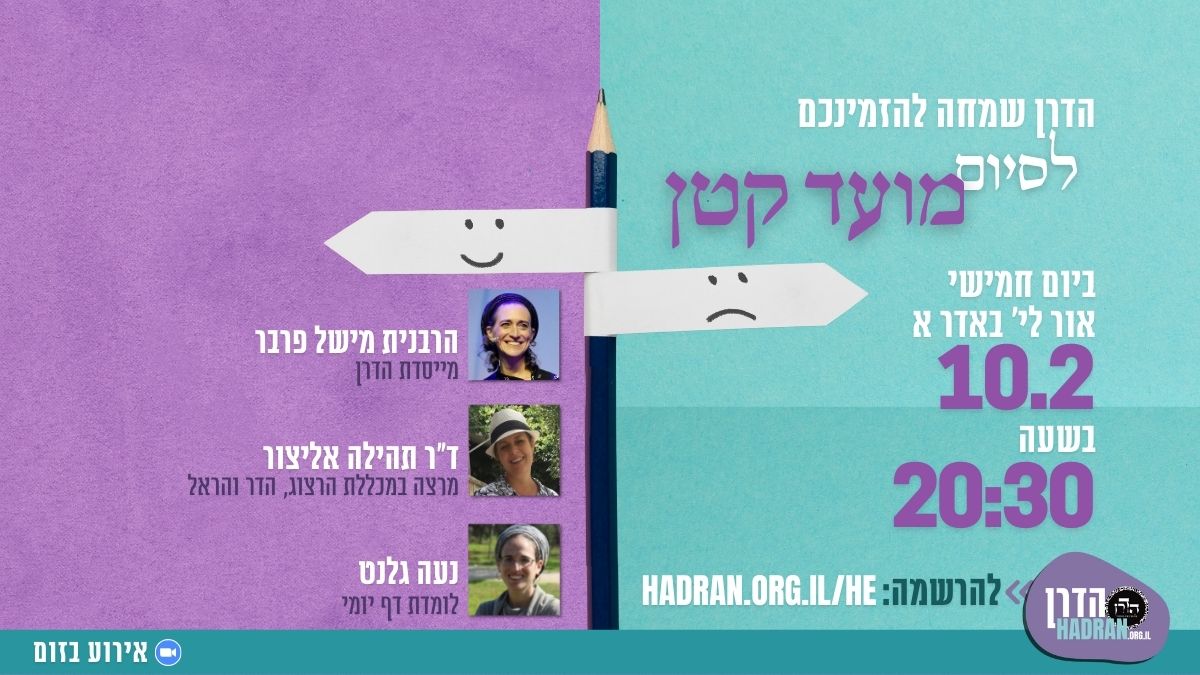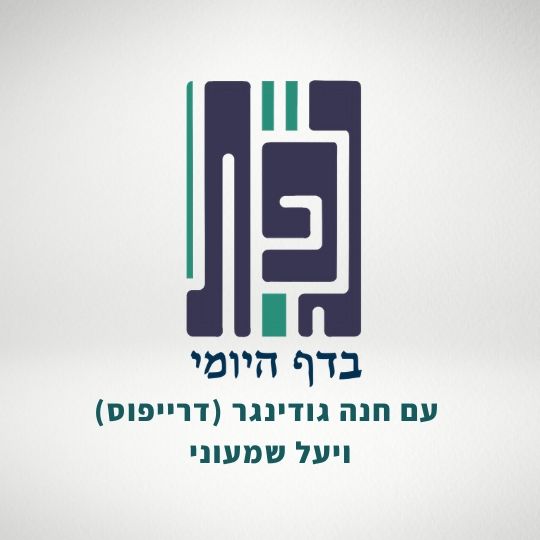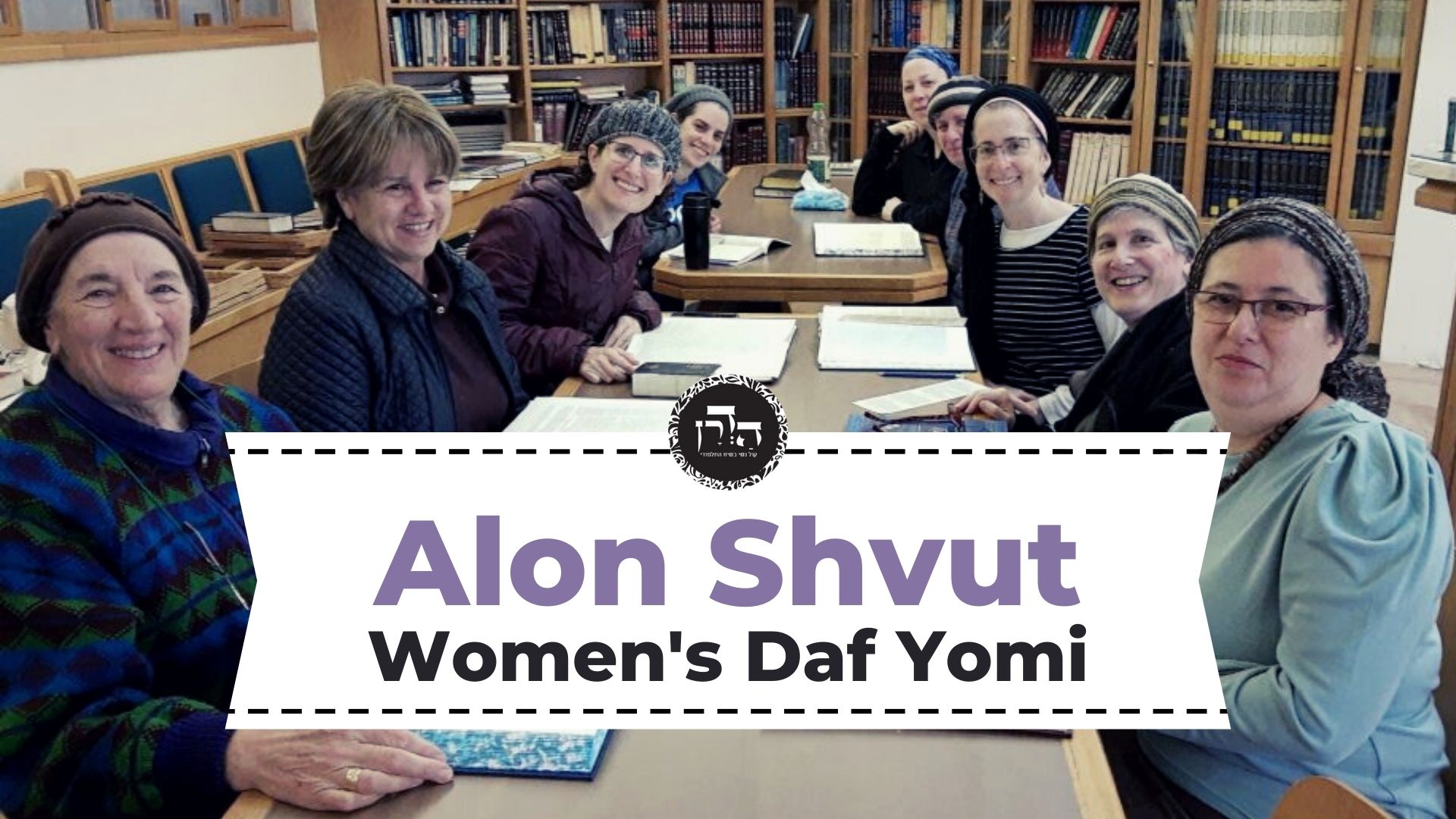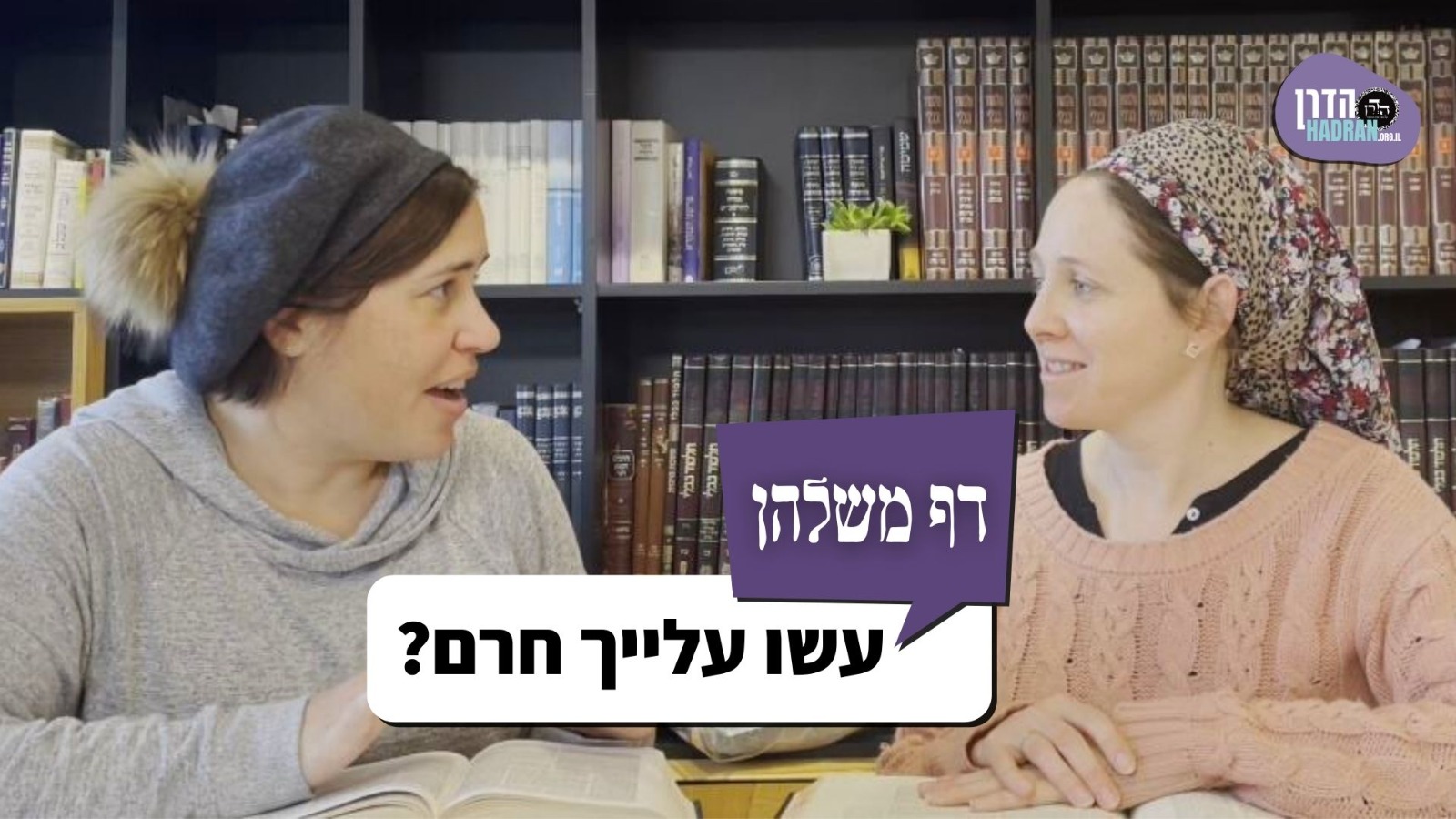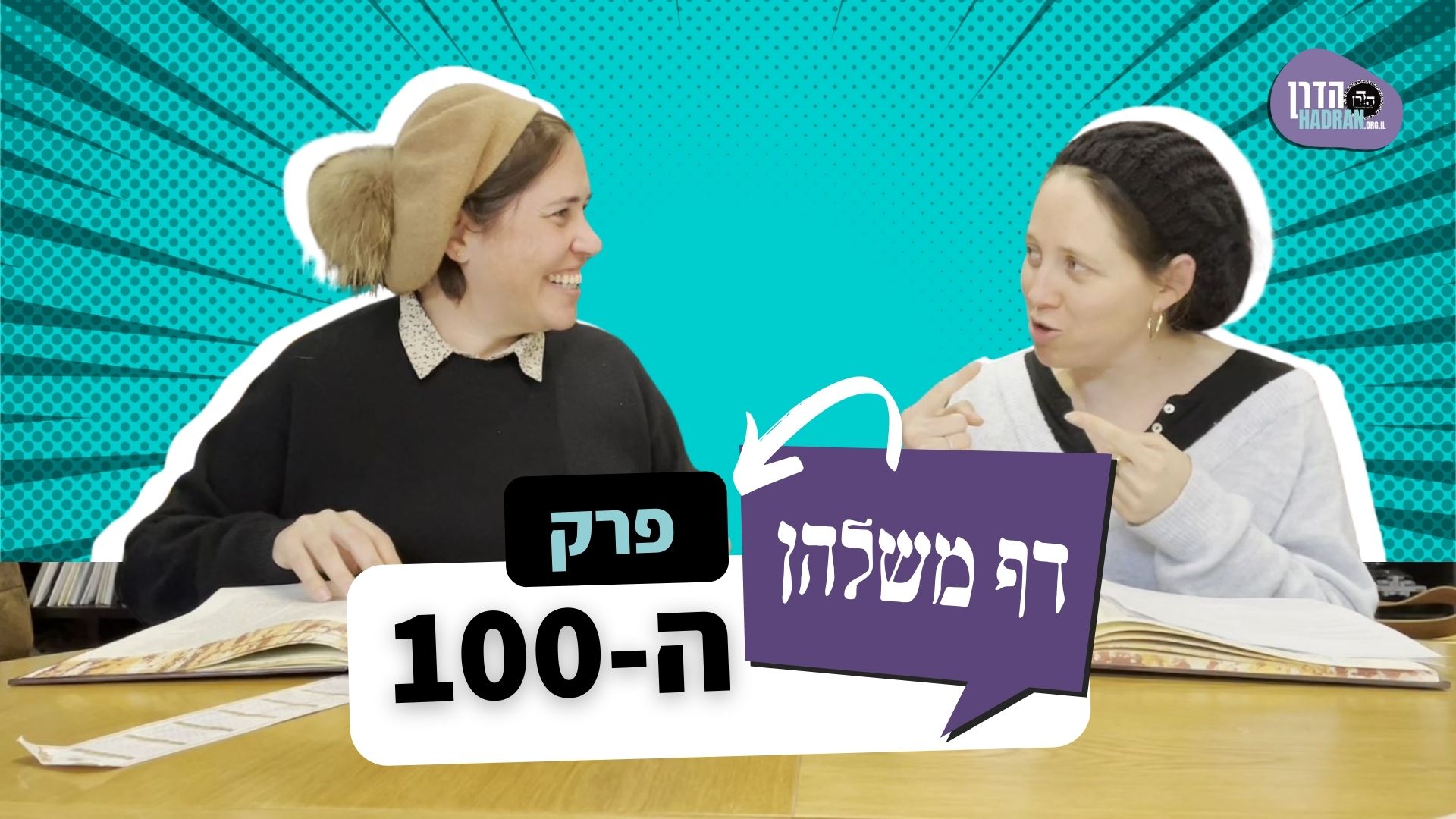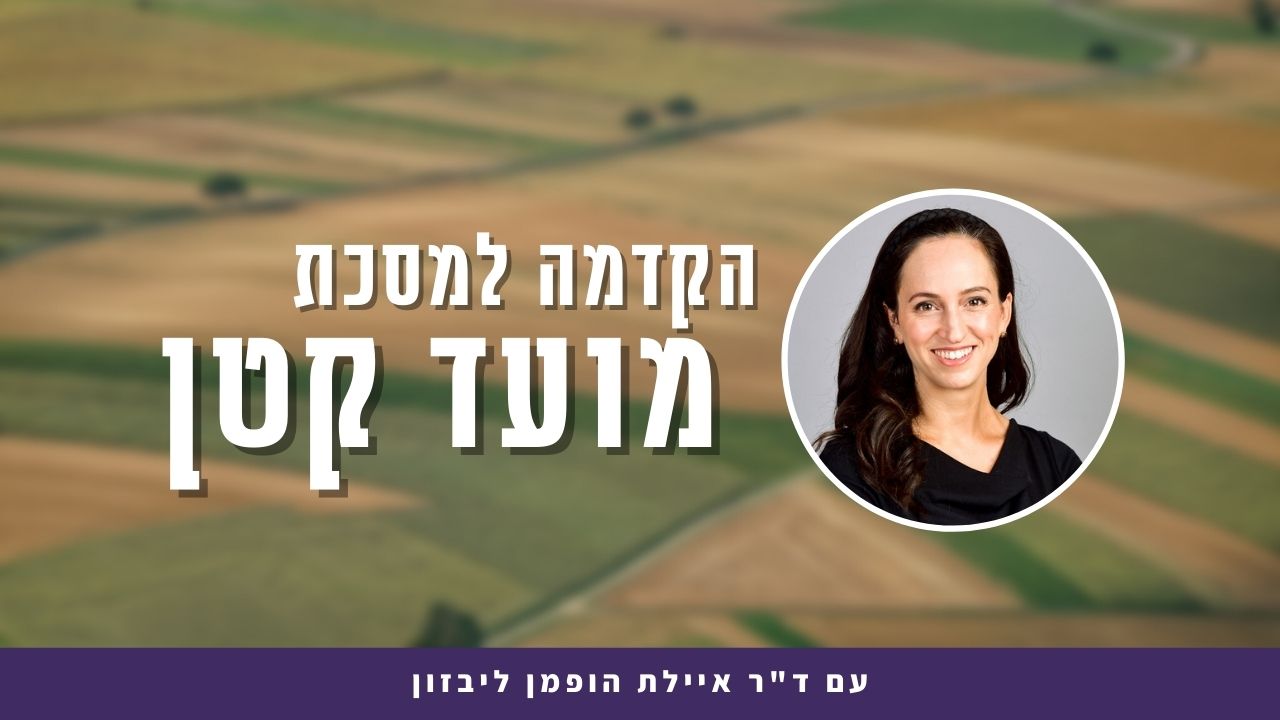מועד קטן ו
וְדִלְמָא טוּמְאָה מִגַּוַּאי וְאִילָנוֹת מִבָּרַאי?
The Gemara asks: But perhaps the ritual impurity was on the inside and the trees were on the outside, and only the area between the trees was plowed, while the inner portion of the field with the grave was not plowed?
בִּמְסוּבָּכִין. וְאִיבָּעֵית אֵימָא, הָא אֲמַרַן: אֵין מַרְחִיקִין צִיּוּן מִמְּקוֹם טוּמְאָה שֶׁלֹּא לְהַפְסִיד אֶת אֶרֶץ יִשְׂרָאֵל.
The Gemara answers: The case is where the trees are scattered throughout the entire field, so that it is likely that the entire field was plowed. And if you wish, say instead: This is not a concern, as we said earlier that one does not distance the marker too far from the actual site of ritual impurity, so as not to cause a loss of Eretz Yisrael. As the marker is located near the trees, presumably the trees are close to the actual site of the grave, and the site of the grave was plowed.
רַבִּי יְהוּדָה אוֹמֵר: עַד שֶׁיְּהֵא שָׁם זָקֵן אוֹ תַּלְמִיד, לְפִי שֶׁאֵין הַכֹּל בְּקִיאִין בַּדָּבָר. אָמַר אַבָּיֵי: שְׁמַע מִינַּהּ צוּרְבָּא מֵרַבָּנַן דְּאִיכָּא בְּמָתָא — כׇּל מִילֵּי דְמָתָא עֲלֵיהּ רַמְיָא.
It is taught in the baraita that Rabbi Yehuda says: One relies on these signs only when there is an Elder or a rabbinic scholar who can testify about the matter, as not all are well versed in this matter, and perhaps the field was not plowed at all. Abaye said: Learn from this statement of Rabbi Yehuda that when there is a Torah scholar in the city, all affairs of the city are thrust upon him, i.e., are his responsibility. Consequently, he is expected to know what has happened in the city.
אָמַר רַב יְהוּדָה: מָצָא אֶבֶן מְצוּיֶּנֶת — תַּחְתֶּיהָ טָמֵא. שְׁתַּיִם, אִם יֵשׁ סִיד בֵּינֵיהֶן — בֵּינֵיהֶן טָמֵא, וְאִם אֵין סִיד בֵּינֵיהֶן — בֵּינֵיהֶן טָהוֹר.
§ The Gemara continues its discussion of marking graves. Rav Yehuda said: If one found a single marked stone, this indicates that the ground underneath it is ritually impure. If he found two marked stones, the following distinction applies: If there is lime on the ground between them, this indicates that the area between them is ritually impure and the two stones mark the boundaries of the impure area; and if there is no lime on the ground between them, this indicates that the area between them is ritually pure and each stone marks a separate area of ritual impurity.
וְאַף עַל גַּב דְּלֵיכָּא חוֹרֶשׁ? וְהָתַנְיָא: מָצָא אֶבֶן אַחַת מְצוּיֶּנֶת — תַּחְתֶּיהָ טָמֵא. שְׁתַּיִם, אִם יֵשׁ חוֹרֶשׁ בֵּינֵיהֶן — בֵּינֵיהֶן טָהוֹר, וְאִם לָאו — בֵּינֵיהֶן טָמֵא!
The Gemara asks: And is the area between them deemed ritually pure even though there is no sign of plowing having taken place between the stones? But isn’t it taught otherwise in a baraita as follows: If one found a single marked stone, this indicates that the ground underneath it is ritually impure. If he found two marked stones, then the following distinction applies: If there is evidence of plowing having taken place between them, the area between the two stones is ritually pure; and if not, the area between them is ritually impure.
אָמַר רַב פָּפָּא: הָכָא כְּשֶׁהַסִּיד שָׁפוּךְ עַל רָאשֵׁיהֶן וּמְרוּדֶּה לְכָאן וּלְכָאן. אִי אִיכָּא חוֹרֶשׁ בֵּינֵיהֶן — בֵּינֵיהֶן טָהוֹר, דְּאֵימוֹר מֵחֲמַת חוֹרֶשׁ הוּא דְּאִיקְּפַל, וְאִי לָא, סִיד דְּבֵינֵי בֵּינֵי הוּא וְטָמֵא.
Rav Pappa said: The contradiction can be resolved by explaining that here, in the baraita, the case is where the lime used as a marker of ritual impurity had been poured on top of the stones, and it is spread thinly this way and that. In this case, if there is evidence of plowing having taken place between the stones, the area between them is ritually pure, as one can say that the lime was peeled off from the stones due to the plowing; originally the lime was only on top of the stones, to indicate that there is ritual impurity underneath them, but then fell into the area between them during the plowing. But if there is no evidence of a plow having passed between them, then it is most likely that the lime was meant to mark the ground between the stones, and the entire area between them is ritually impure.
אָמַר רַבִּי אַסִּי מֶצֶר אֶחָד מְצוּיָּן — הוּא טָמֵא, וְכׇל הַשָּׂדֶה כּוּלָּהּ טְהוֹרָה. שְׁנַיִם — הֵם טְמֵאִין, וְכׇל הַשָּׂדֶה כּוּלָּהּ טְהוֹרָה. שְׁלֹשָׁה — הֵם טְמֵאִין, וְכׇל הַשָּׂדֶה כּוּלָּהּ טְהוֹרָה. אַרְבָּעָה — הֵן טְהוֹרִין, וְכׇל הַשָּׂדֶה כּוּלָּהּ טְמֵאָה.
Rabbi Asi said: If only one border of a field is marked, it is assumed that the border itself is ritually impure while the entire rest of the field is ritually pure. If two borders are marked, it is assumed that they are both ritually impure while the entire rest of the field is ritually pure. If three borders are marked, it is assumed that the three of them are ritually impure while the entire rest of the field is ritually pure. If all four borders are marked, the borders themselves are ritually pure, while the entire field enclosed by the borders is ritually impure.
דְּאָמַר מָר: אֵין מַרְחִיקִין צִיּוּן מִמְּקוֹם טוּמְאָה, שֶׁלֹּא לְהַפְסִיד אֶת אֶרֶץ יִשְׂרָאֵל.
As the Master said in the baraita: One does not distance the marker from the actual site of ritual impurity, so as not to cause a loss of Eretz Yisrael, i.e., not to increase the area into which people refrain from entering. Consequently, they marked all of the borders to indicate that the entire field is ritually impure.
וְיוֹצְאִין אַף עַל הַכִּלְאַיִם.
§ It is taught in the mishna: And inspectors even go out on the intermediate days of a Festival to uproot the shoots of prohibited diverse kinds [kilayim] that grew in the fields during the rainy season.
וְאַכִּלְאַיִם בְּחוּלּוֹ שֶׁל מוֹעֵד נָפְקִינַן? וּרְמִינְהוּ: בְּאֶחָד בַּאֲדָר מַשְׁמִיעִין עַל הַשְּׁקָלִים וְעַל הַכִּלְאַיִם.
The Gemara asks: Do they go out to uproot diverse kinds during the intermediate days of a Festival? The Gemara raises a contradiction from another mishna (Shekalim 1:1), which states: On the first of Adar the court issues a proclamation concerning the collection of the shekels, i.e., the yearly half-shekel contribution to the Temple treasury made by each adult male for the purpose of buying communal offerings. And the court also issues a proclamation with regard to the obligation to uproot diverse kinds from the fields.
בַּחֲמִשָּׁה עָשָׂר בּוֹ קוֹרִין אֶת הַמְּגִילָּה בַּכְּרַכִּים, וְיוֹצְאִין לְקַוֵּוץ אֶת הַדְּרָכִים, וּלְתַקֵּן הָרְחוֹבוֹת, וְלָמוֹד הַמִּקְוָאוֹת. וְעוֹשִׂין כׇּל צוֹרְכֵי רַבִּים, וּמְצַיְּנִין אֶת הַקְּבָרוֹת, וְיוֹצְאִין עַל הַכִּלְאַיִם.
On the fifteenth of Adar the Megilla, the Scroll of Esther, is read in the walled cities, and they go out to clear thorns from the roads, to repair the city streets, and to measure the ritual baths to ascertain that they have the requisite quantity of water. And they tend to all other public needs, and they mark graves with lime, and they go out to uproot the shoots of diverse kinds. If they already went out in Adar to uproot the diverse kinds, why would they go out again on the intermediate days of the festival of Passover?
רַבִּי אֶלְעָזָר וְרַבִּי יוֹסֵי בַּר חֲנִינָא, חַד אָמַר: כָּאן בְּבַכִּיר, כָּאן בְּאָפִיל. וְחַד אָמַר: כָּאן בִּזְרָעִים, כָּאן בִּירָקוֹת.
Rabbi Elazar and Rabbi Yosei bar Ḥanina disagreed about this issue: One said: Here, in the mishna that states that they go out on the fifteenth of Adar, it is referring to the early crop, while there, in the mishna that states that they go out on the intermediate days of the Festival, it is referring to the late crop, which isn’t clearly recognizable until the intermediate days of Passover. And one said: Here, in the mishna that states that they go out on the fifteenth of Adar, it is referring to grains that are sown in the winter and have already grown tall by Adar, while there, in the mishna that states that they go out on the intermediate days of the Festival, it is referring to vegetables, which only grow later in the season.
אָמַר רַבִּי אַסִּי אָמַר רַבִּי יוֹחָנָן: לֹא שָׁנוּ אֶלָּא שֶׁאֵין נִיצָּן נִיכָּר, אֲבָל נִיצָּן נִיכָּר — יוֹצְאִין עֲלֵיהֶן.
Rabbi Asi said that Rabbi Yoḥanan said: They taught that court messengers go out to uproot diverse kinds in the middle of the month of Adar only in a case where the blossom was not yet recognizable at an earlier date, so it was still impossible to determine whether or not the seedling was from diverse kinds of seeds. But if the blossom was already recognizable at an earlier date, they go out at that time to uproot the shoots of diverse kinds of seeds.
מַאי שְׁנָא בְּחוּלּוֹ שֶׁל מוֹעֵד דְּנָפְקִינַן? אָמַר רַבִּי יַעֲקֹב אָמַר רַבִּי יוֹחָנָן: מִשּׁוּם שְׂכַר פְּעוּלָה דְּמוֹזְלִי גַּבַּן.
The Gemara asks: What is different about the intermediate days of a Festival that we specifically go out to uproot shoots of diverse kinds of seeds during that week? Rabbi Ya’akov said that Rabbi Yoḥanan said: It is due to the wages paid to the workers hired by the court to uproot the diverse kinds. On the intermediate days of the Festival it is prohibited for them to perform ordinary labor, and so they reduce their rates for us, i.e., for public works, as otherwise they would have no income at all.
אָמַר רַב זְבִיד וְאִיתֵּימָא רַב מְשַׁרְשְׁיָא: שְׁמַע מִינַּהּ, כִּי יָהֲבִינַן לְהוּ שָׂכָר — מִתְּרוּמַת הַלִּשְׁכָּה יָהֲבִינַן לְהוּ. דְּאִי סָלְקָא דַעְתָּךְ מִדִּידְהוּ יָהֲבִינַן לְהוּ — מַאי נָפְקָא לַן מִינַּיְיהוּ? כֹּל כַּמָּה דְּבָעוּ לִיתֵּן לְהוּ!
Rav Zevid said, and some say that it was Rav Mesharshiyya who said: Learn from this explanation that when we give the workers who uproot the diverse kinds their wages, we give it to them from the funds of the collection of the Temple treasury chamber. Since they are paid with consecrated money, an attempt is made to minimize the expenses. As, if it enters your mind that we pay them from theirs, i.e., the court forces the owners of the fields where the diverse kinds are found to pay the workers who uproot them, what benefit would we derive from saving the expense? However much the workers desire, they should pay them.
וְעַד כַּמָּה? אָמַר רַב שְׁמוּאֵל בַּר יִצְחָק, כְּאוֹתָהּ שֶׁשָּׁנִינוּ: כׇּל סְאָה שֶׁיֵּשׁ בָּהּ
Concerning the issue of uprooting diverse kinds, the Gemara asks: And how much of another species must be mixed in with a crop in order to be considered diverse kinds that must be uprooted by these workers? Rav Shmuel bar Yitzḥak said: The amount is like that which we learned in the mishna (Kilayim 2:1): Any se’a of seeds that contains
רוֹבַע זֶרַע מִמִּין אַחֵר — יְמַעֵט.
a quarter–kav or more of seeds of a different type, i.e., one twenty-fourth of the mixture is a type of seed other than the main type, one must reduce the other type of seeds in the mixture by uprooting the shoots.
וְהָתַנְיָא: הִתְקִינוּ שֶׁיְּהוּ מַפְקִירִין כׇּל הַשָּׂדֶה כּוּלָּהּ! לָא קַשְׁיָא: כָּאן קוֹדֶם תַּקָּנָה, כָּאן לְאַחַר תַּקָּנָה.
With regard to the halakha that inspectors must go out and uproot the shoots of diverse kinds of seeds that grew in the fields, the Gemara asks: But isn’t it taught in a baraita that the Sages ordained that they should pronounce the crop of the entire field in which diverse kinds was found ownerless, rather than uprooting the diverse kinds? The Gemara responds: This is not difficult. Here, in the mishna, where it says that the inspectors go out and uproot the diverse kinds, it is referring to the time before the institution of the new ordinance; there, in the baraita, where it says that the entire field is pronounced ownerless, it is referring to the time after the institution of that ordinance.
דְּתַנְיָא: בָּרִאשׁוֹנָה הָיוּ עוֹקְרִין וּמַשְׁלִיכִין לִפְנֵי בְּהֶמְתָּן, וְהָיוּ בַּעֲלֵי בָּתִּים שְׂמֵחִין שְׁתֵּי שְׂמָחוֹת: אַחַת שֶׁמְּנַכְּשִׁין לָהֶם שְׂדוֹתֵיהֶן, וְאַחַת שֶׁמַּשְׁלִיכִין לִפְנֵי בְּהֶמְתָּם,
The Gemara explains this ordinance as it is taught in another baraita: At first, the agents of the court would uproot the diverse kinds and cast them before the livestock belonging to the owners of the fields. However, the property holders would rejoice for two reasons: One, that the agents of the court weeded their fields for them when they uprooted the plants of the other type; and another one, that they cast the diverse kinds before their livestock, thereby saving them from having to feed them. Accordingly, the field owners took no steps to keep their fields free of diverse kinds of seeds.
הִתְקִינוּ שֶׁיְּהוּ עוֹקְרִין וּמַשְׁלִיכִין עַל הַדְּרָכִים. וַעֲדַיִין הָיוּ שְׂמֵחִין שִׂמְחָה גְּדוֹלָה שֶׁמְּנַכְּשִׁין שְׂדוֹתֵיהֶן, הִתְקִינוּ שֶׁיְּהוּ מַפְקִירִין כׇּל הַשָּׂדֶה כּוּלָּהּ.
The Sages, therefore, ordained that the agents of the court should uproot the diverse kinds and cast them on the roads. Yet the property holders would still greatly rejoice that the agents of the court weeded their fields free of charge. Finally, the Sages ordained that they should pronounce the crop of the entire field in which diverse kinds was found ownerless.
מַתְנִי׳ רַבִּי אֱלִיעֶזֶר בֶּן יַעֲקֹב אוֹמֵר: מוֹשְׁכִין אֶת הַמַּיִם מֵאִילָן לְאִילָן, וּבִלְבַד שֶׁלֹּא יַשְׁקֶה אֶת כׇּל הַשָּׂדֶה. זְרָעִים שֶׁלֹּא שָׁתוּ לִפְנֵי הַמּוֹעֵד — לָא יַשְׁקֵם בַּמּוֹעֵד. וַחֲכָמִים מַתִּירִין בָּזֶה וּבָזֶה.
MISHNA: Rabbi Eliezer ben Ya’akov says: In a field that is filled with trees, one may draw water via channels from one tree to another tree on the intermediate days of a Festival because trees are in dire need of water. And this is permitted provided that in doing so he does not water the entire field. With regard to plants that were not watered prior to the Festival, one may not water them on the intermediate days of the Festival because they do not need the water. But the Rabbis permit watering in this case, i.e., trees, and that case, i.e., plants.
גְּמָ׳ אָמַר רַב יְהוּדָה: אִם הָיְתָה שָׂדֶה מְטוּנֶּנֶת — מוּתָּר. תַּנְיָא נָמֵי הָכִי: כְּשֶׁאָמְרוּ אָסוּר לְהַשְׁקוֹתָן בַּמּוֹעֵד, לֹא אָמְרוּ אֶלָּא בִּזְרָעִים שֶׁלֹּא שָׁתוּ מִלִּפְנֵי הַמּוֹעֵד, אֲבָל זְרָעִים שֶׁשָּׁתוּ לִפְנֵי הַמּוֹעֵד — מוּתָּר לְהַשְׁקוֹתָן בַּמּוֹעֵד.
GEMARA: Rav Yehuda said: If the field was moist [metunenet] before the Festival but in the meantime it dried up, it is permitted to water the entire field even according to Rabbi Eliezer ben Ya’akov. That ruling is also taught in a baraita: When they said that it is prohibited to water them on the intermediate days of a Festival, they said this only with regard to plants that were not watered at all before the Festival. However, with regard to plants that were already watered before the Festival and had begun to grow, it is permitted to water them on the intermediate days of the Festival because failure to water them would lead to substantial financial loss.
וְאִם הָיְתָה שָׂדֶה מְטוּנֶּנֶת — מוּתָּר. וְאֵין מַשְׁקִין שְׂדֵה גָרִיד בַּמּוֹעֵד, וַחֲכָמִים מַתִּירִין בָּזֶה וּבָזֶה.
And if the field was moist before the Festival, it is permitted to water it even if the field had not been watered prior to the Festival. And one may not water a dry field on the intermediate days of a Festival. But the Rabbis permit watering this and that, i.e., plants that were not watered before the Festival and a dry field.
אָמַר רָבִינָא: שְׁמַע מִינַּהּ הַאי תַּרְבִּיצָא שְׁרֵי לְתַרְבּוֹצֵי בְּחוּלָּא דְמוֹעֲדָא. שְׂדֵה גָרִיד מַאי טַעְמָא — דְּאַפְלָא מְשַׁוֵּי לַהּ חָרְפָא, הָכָא נָמֵי — אַפְלָא מְשַׁוֵּי לָהּ חָרְפָא.
Ravina said: Learn from here that one is permitted to sprinkle a garden [tarbitza] with water on the intermediate days of a Festival. Ravina explains how he arrived at this conclusion: What is the reason that the Rabbis permit one to water a dry field despite the fact that the plants will not die from a lack of moisture? This is because watering the field in advance turns a late crop into an early crop. It can be understood from this that the late ripening of a crop is considered a substantial financial loss that serves as a reason to permit labor that would otherwise be prohibited on the intermediate days of a Festival. Here too, in the case of a garden, sprinkling it with water turns a late crop into an early crop, and so it is permitted on the intermediate days of a Festival.
תָּנוּ רַבָּנַן: מַרְבִּיצִין שְׂדֵה לָבָן בַּשְּׁבִיעִית, אֲבָל לֹא בַּמּוֹעֵד.
The Sages taught the following baraita: One may sprinkle water in a field of grain during the Sabbatical Year, but not on the intermediate days of a Festival.
וְהָא תַּנְיָא: מַרְבִּיצִין בֵּין בַּמּוֹעֵד בֵּין בַּשְּׁבִיעִית! אָמַר רַב הוּנָא, לָא קַשְׁיָא: הָא רַבִּי אֱלִיעֶזֶר בֶּן יַעֲקֹב, הָא רַבָּנַן.
The Gemara asks: But isn’t it taught in another baraita: One may sprinkle water in a field of grain both on the intermediate days of a Festival and during the Sabbatical Year? Rav Huna said: This is not difficult. This baraita that prohibits sprinkling water in a field of grain on the intermediate days of a Festival is in accordance with the opinion of Rabbi Eliezer ben Ya’akov, who prohibits watering an entire field. That baraita that permits it is in accordance with the more lenient opinion of the Rabbis.
תַּנְיָא אִידַּךְ: מַרְבִּיצִין שְׂדֵה לָבָן עֶרֶב שְׁבִיעִית כְּדֵי שֶׁיֵּצְאוּ יְרָקוֹת בַּשְּׁבִיעִית, וְלֹא עוֹד אֶלָּא שֶׁמַּרְבִּיצִין שְׂדֵה לָבָן בַּשְּׁבִיעִית כְּדֵי שֶׁיֵּצְאוּ יְרָקוֹת לְמוֹצָאֵי שְׁבִיעִית.
It is taught in another baraita: One may sprinkle water in a white field on the eve of the Sabbatical Year so that vegetables will sprout during the Sabbatical Year; and not only that, but one may sprinkle water in a field of grain even during the Sabbatical Year itself, so that vegetables will sprout upon the conclusion of the Sabbatical Year. Since sprinkling water is not regarded as full-fledged agricultural labor, it is permitted as long as the sprinkling and the sprouting of the vegetables do not both occur during the Sabbatical Year itself.
מַתְנִי׳ צָדִין אֶת הָאִישׁוּת וְאֶת הָעַכְבָּרִים מִשְּׂדֵה הָאִילָן וּמִשְּׂדֵה הַלָּבָן כְּדַרְכּוֹ בַּמּוֹעֵד וּבִשְׁבִיעִית. וַחֲכָמִים אוֹמְרִים: מִשְּׂדֵה הָאִילָן — כְּדַרְכּוֹ, וּמִשְּׂדֵה הַלָּבָן — שֶׁלֹּא כְּדַרְכּוֹ.
MISHNA: One may trap moles [ishut] and mice in an orchard and in a field of grain in his usual manner, i.e., as he would trap them all year round, both on the intermediate days of a Festival and during the Sabbatical Year. But the Rabbis say: In an orchard he may trap them in his usual manner, but in a field of grain, where there is no danger of substantial financial loss, he may only trap them in a way that is not his usual manner.
וּמְקָרִין אֶת הַפִּירְצָה בַּמּוֹעֵד, וּבַשְּׁבִיעִית בּוֹנֶה כְּדַרְכּוֹ.
And one may seal a breach in the wall of his garden on the intermediate days of a Festival, and during the Sabbatical Year one may even build a wall in his usual manner, as this is not considered an agricultural labor. Consequently, despite the fact that this benefits the garden by offering it protection, it is not prohibited during the Sabbatical Year.
גְּמָ׳ מַאי אִישׁוּת? אָמַר רַב יְהוּדָה: בְּרִיָּה שֶׁאֵין לָהּ עֵינַיִם. אָמַר רָבָא בַּר יִשְׁמָעֵאל וְאִיתֵּימָא רַב יֵימַר בַּר שֶׁלֶמְיָא: מַאי קְרָא? ״כְּמוֹ שַׁבְּלוּל תֶּמֶס יַהֲלֹךְ נֵפֶל אֵשֶׁת בַּל חָזוּ שָׁמֶשׁ״.
GEMARA: The Gemara asks: What is meant by the term ishut? Rav Yehuda said: An ishut is a creature that has no eyes, a rodent that digs holes in the ground and can cause damage to roots and vegetables. Rava bar Yishmael said, and some say that it was Rav Yeimar bar Shelamya who said: What is the verse that indicates the identity of the ishut? “As a snail that melts and disappears; like the fall of a young mole [eshet] that has not seen the sun” (Psalms 58:9). It is understood that this creature has not seen the sun because it does not have eyes.
תָּנוּ רַבָּנַן: צָדִין אֶת הָאִישׁוּת וְאֶת הָעַכְבָּרִים מִשְּׂדֵה הַלָּבָן וּמִשְּׂדֵה הָאִילָן כְּדַרְכּוֹ, וּמַחְרִיבִין חוֹרֵי נְמָלִים. כֵּיצַד מַחְרִיבִין? רַבָּן שִׁמְעוֹן בֶּן גַּמְלִיאֵל אוֹמֵר: מֵבִיא עָפָר מֵחוֹר זֶה וְנוֹתֵן לְתוֹךְ חוֹר זֶה, וְהֵן חוֹנְקִין זֶה אֶת זֶה.
The Gemara expands upon the halakha recorded in the mishna. The Sages taught the following baraita: One may trap moles and mice in a field of grain and in an orchard in his usual manner, and one may destroy ant holes so that the ants will cause no damage. How does one destroy ant holes? Rabban Shimon ben Gamliel says: One brings soil from this ant hole and places it in that ant hole, and since the ants from the two nests are not familiar with each other, they strangle each other.
אָמַר רַב יֵימַר בַּר שֶׁלֶמְיָא מִשְּׁמֵיהּ דְּאַבָּיֵי: וְהוּא דְּקָאֵי בִּתְרֵי עֶבְרֵי נַהֲרָא, וְהוּא דְּלֵיכָּא גִּשְׁרָא, וְהוּא דְּלֵיכָּא גַּמְלָא, וְהוּא דְּלֵיכָּא מִצְרָא.
Rav Yeimar bar Shelamya said in the name of Abaye: And this advice works only in certain circumstances: When the ant holes are located on two opposite sides of a river, when there is no bridge connecting the two sides, when there is not even a plank bridge over the water, and when there is not even a rope stretched taut across the river. If there is any connection whatsoever between the two sides of the river, the ants from the two nests are likely to recognize each other and not fight.

